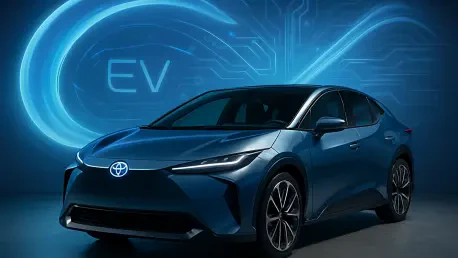In the ever-evolving landscape of the global automotive industry, Toyota has emerged as a pivotal player with a bold new direction that could reshape the trajectory of electric vehicles (EVs) and sustainable mobility. With the recent transition to Koji Sato as CEO, replacing the long-standing Akio Toyoda, the company is sending a clear signal of its intent to prioritize innovation and adapt to pressing environmental and competitive challenges. This leadership change is more than a mere reshuffle; it represents a strategic pivot at a time when the demand for green technology is no longer a distant goal but an immediate necessity. As automakers worldwide race to dominate the EV market, Toyota’s latest move under Sato’s guidance sparks curiosity about how this shift will influence its standing in the industry and whether it can lead the charge in redefining transportation for a sustainable era.
A New Era of Leadership and Vision
Strategic Focus on Electric Innovation
Under Koji Sato’s stewardship, Toyota is embarking on a transformative journey to cement its position as a leader in the EV sector, a stark contrast to its historically cautious approach to full electrification. This shift comes as global pressures mount for automakers to reduce carbon footprints and meet stringent emissions regulations, with many competitors already gaining ground in the EV space. Sato, known for his forward-thinking mindset, is tasked with accelerating the company’s electrification strategy, ensuring that Toyota not only keeps pace but sets new benchmarks. The emphasis is on expanding the lineup of battery electric vehicles (BEVs) while integrating cutting-edge technologies to enhance efficiency and appeal. This direction aligns with broader industry trends, where sustainability is no longer a choice but a mandate, pushing Toyota to rethink its legacy of hybrid dominance and dive deeper into pure electric solutions.
The implications of this strategic focus extend beyond product development to reshaping Toyota’s brand identity in the eyes of consumers and stakeholders alike. By prioritizing EVs, the company aims to address growing environmental concerns and capture a younger, eco-conscious demographic that values green innovation. Analysts suggest that Sato’s leadership will likely involve significant investments in research and development, particularly in battery technology, to overcome current limitations like range anxiety and charging infrastructure gaps. Furthermore, partnerships with tech firms and energy providers could play a crucial role in building a robust ecosystem for EV adoption. This proactive stance marks a departure from past hesitancy, positioning Toyota to potentially redefine market expectations and influence global standards for sustainable automotive solutions over the coming years.
Implications for Corporate Culture
Toyota’s leadership transition under Koji Sato also signals a broader shift in corporate culture, moving away from the traditionally conservative decision-making that has long defined Japanese automakers. This change is driven by the urgent need to adapt to rapid technological advancements and fierce global competition, where agility often trumps caution. Sato’s appointment reflects a willingness to embrace risk and innovation, qualities essential for navigating the complexities of the modern automotive landscape. By fostering a more dynamic and responsive corporate environment, Toyota aims to break free from rigid hierarchies and encourage quicker, more adaptive strategies that can respond to market shifts in real time. This cultural evolution is seen as a critical step in maintaining relevance in an industry increasingly dominated by tech-driven disruptors.
Beyond internal changes, this cultural shift could have a ripple effect across Japan’s corporate sector, where many companies face similar pressures to modernize. Toyota’s move to prioritize innovation over tradition under Sato’s guidance may inspire other firms to reassess their own structures and strategies, potentially sparking a wave of transformation. The focus on agility also means empowering teams to experiment with bold ideas, from autonomous driving technologies to next-generation mobility services, without the fear of slow bureaucratic delays. Market observers note that while this transition may face initial resistance within the organization, the long-term benefits of a more innovative and flexible culture could position Toyota as a trailblazer, not just in automotive manufacturing but in corporate governance as well.
Market Impact and Future Outlook
Investor Sentiment and Financial Projections
The announcement of Koji Sato as Toyota’s new CEO initially triggered a mixed response in the financial markets, with the company’s stock (7203.T) experiencing a short-term dip of 3.67%, closing at ¥2898.5. This reaction reflects typical market uncertainty following significant leadership changes, as investors weigh the risks and opportunities of a new strategic direction. However, deeper analysis reveals a more optimistic outlook, with forecasts predicting a potential stock price of ¥3180.41 within a year from now. This projected growth underscores confidence in Toyota’s pivot toward EVs and sustainable technologies, suggesting that investors see long-term value in Sato’s vision despite short-term fluctuations. The spike in public interest, evidenced by a 200% increase in search volume for related news, further highlights the market’s keen focus on the company’s next moves.
Looking ahead, Toyota’s financial trajectory under Sato’s leadership will likely hinge on the successful execution of its electrification goals and the ability to capture a significant share of the growing EV market. Analysts point to the company’s strong balance sheet and history of resilience as factors that could mitigate risks associated with this transition. Additionally, strategic investments in battery production and partnerships for charging infrastructure are expected to bolster investor trust by demonstrating tangible progress. While immediate market reactions may remain cautious, the consensus is that Toyota’s commitment to innovation could yield substantial returns, potentially redefining its valuation and competitive standing. This evolving sentiment reflects a broader belief that embracing change, though challenging, is essential for sustained growth in today’s automotive industry.
Competitive Positioning in the EV Landscape
Toyota’s strategic pivot under Koji Sato places it in direct competition with established EV leaders and emerging disruptors, each vying for dominance in a rapidly expanding market. Historically known for its hybrid technology, the company now faces the challenge of carving out a distinct space in the pure electric segment, where rivals have already built strong brand loyalty. Sato’s mandate appears to prioritize not just catching up but innovating beyond current offerings, with plans to introduce a diverse range of BEVs tailored to different consumer needs. This approach aims to differentiate Toyota by leveraging its reputation for reliability while integrating advanced features like autonomous driving and connected vehicle systems, positioning it as a formidable contender in the global race for EV supremacy.
Beyond product innovation, Toyota’s competitive edge under this new leadership will depend on its ability to scale production efficiently and address supply chain constraints, particularly for critical components like batteries. Collaborations with global suppliers and investments in sustainable manufacturing practices are expected to play a key role in overcoming these hurdles. Moreover, Sato’s vision includes a focus on affordability, ensuring that Toyota’s EVs appeal to a broad audience rather than a niche premium segment. As the industry continues to evolve, this strategic positioning could enable Toyota to not only compete but also influence market trends, setting new standards for accessibility and sustainability. The coming years will test whether this bold direction can translate into a leadership role amidst fierce competition and shifting consumer expectations.
Reflecting on a Transformative Shift
Looking back, Toyota’s decision to appoint Koji Sato as CEO marked a pivotal moment that reshaped its approach to the automotive industry’s future. The transition reflected a determined effort to embrace electric innovation and sustainability, responding to global demands with a renewed sense of purpose. While initial market hesitations were evident in stock fluctuations, the long-term confidence from investors and analysts highlighted a belief in the company’s potential to lead in the EV space. Moreover, the cultural shift within Toyota challenged traditional Japanese corporate norms, setting an example for agility and adaptability. As the industry moved forward, it became clear that this leadership change was not just a reaction to trends but a proactive step that positioned Toyota to influence the broader landscape of mobility and corporate strategy for years to come.









